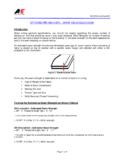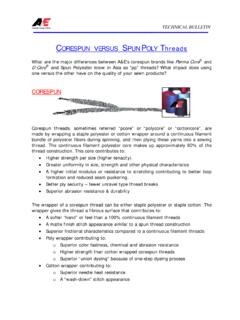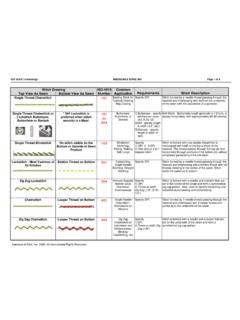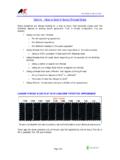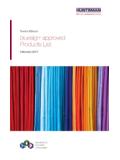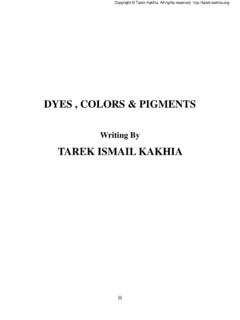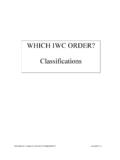Transcription of Over-Dyeing or Piece-Dyeing Assembled Garments
1 TECHNICAL BULLETIN. Over-Dyeing or Piece-Dyeing Assembled Garments What thread should be used in seaming Garments that will be over-dyed after they are Assembled ? Careful consideration should be given to this question because not all thread types will dye the same resulting in a contrasting thread when compared to the fabric it is being sewn into. Most products being piece-dyed are 100% cotton fabrics which generally should be sewn with 100% cotton sewing threads. But what size, type, finish, and color thread should be recommended? Below is a list of factors that should be considered when selecting 100% cotton threads: THREAD SIZE AND STRENGTH.
2 Today, it is far more common to assemble Garments with polyester sewing threads rather than cotton sewing threads because cotton sewing threads are much weaker than polyester threads and they are generally also more expensive. However, when you are constructing 100% cotton Garments that will be Over-dyed or Piece-dyed, then you MUST used 100% cotton sewing threads. Also, due to cotton's lower tenacity, larger cotton threads will be required to attain the same seam strength of Garments usually sewn with polyester threads. For example, a T-40 Perma Core thread has an average breaking strength of lbs.
3 , where a T-80 Anecot-Plus soft cotton thread breaks at only lbs. Notice that the cotton thread Tex size is twice the size of the core thread even though they are approximately the same strength. This is due to the difference in tenacities between cotton fibers and polyester fibers. GRADE OF COTTON FIBER. 100% Cotton sewing threads can be made from either Pima (SAK) cotton or Peeler (CP) cotton. SAK cotton threads are stronger than CP cotton threads of the same size and are recommended where you need a higher strength thread to replace a polyester thread when Over-Dyeing Assembled Garments . If these grades of cotton threads are mixed on the same garment that is being over-dyed, these two types of cottons may dye a slightly different shades especially on light pastel colors.
4 If you are sewing T-Shirt that will be overdyed, we recommend that you use a T-30 Anecot Plus to replace a T-21 spun polyester or T-18. Wildcat Plus . Obviously a T-30 size thread will require a slightly larger needle than a T-21 or T-18 that may contribute to more needle cutting, however, a T-30 Anecot Plus thread would generally be required to give adequate seam strength. Anecot Plus T-30, T-40, T-50, Pima (SAK) for general Over-Dyeing applications T-60, T-70, T-80, T-90, T-105, T-135. Anecot T-30, T-40, T-50, Peeler (CS) for general Over-Dyeing applications T-60, T-70, T-80, - lower tenacity than Anecot Plus, but less expensive.
5 T-90, T-105 - not as durable as Anecot Plus or Anecot X-tra. 100% COTTON THREAD FINISHES. Cotton sewing threads are usually available with either Soft' or Mercerized' finishes. Mercerization increases the thread's affinity for dyes and even makes the thread stronger. However, most fabrics that are used to make the over-dyed Garments are not made from mercerized cotton yarns and therefore soft' cotton threads are normally used. TECHNICAL BULLETIN. Soft' or Mercerized' threads can be ordered either natural' or bleached white'. If the Garments are made from bleached fabrics then most manufacturers will use bleached sewing threads.
6 Most of our bleached 100% cotton sewing threads also contain an optical brightener. If bleached threads without an optical brightener is needed, then this will have to be specially processed and may take more time. Many manufacturers prefer using natural cotton threads so they can segregate the 100% cotton thread from the 100% polyester threads on the sewing floor. This is because both bleached white' 100% cotton threads and 100% polyester threads are both white and can easily be mistaken for one another. Polyester sewing threads will not accept the 100% cotton dyes used in the Over-Dyeing process.
7 LYOCELL . Sometimes a cellulosic thread with greater resistance to enzymes is needed for over-dye programs. One solution would be to use A&E's Endurance brand that is made from Lyocell fiber. Lyocell threads were actually designed for sewing Tencel Garments that are overdyed and enzyme washed to maximize the softness of the Garments . This fiber is very resistance to enzyme degradation as compared to regular cotton threads. SUMMARY. From the preceding comments you can see that there are a variety of cotton threads available and each variation may slightly change the shade when piece dyeing . We suggest that you test your components to insure you will obtain the desirable results.


